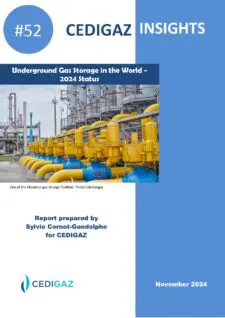
Underground Gas Storage in the World - 2024 Status
| Non Member | 1200 € | |
| Member | FREE | Login |
In an era marked by fluctuating energy markets and geopolitical tensions, the importance of underground gas storage (UGS) has never been more pronounced. As the backbone of global gas security, UGS facilities play a critical role in balancing supply and demand, mitigating price volatility, and ensuring a stable energy supply during peak consumption periods. The recent global gas crisis has thrust UGS into the spotlight, prompting accelerated growth and renewed investment in this vital infrastructure.
By the end of 2023, the global working gas capacity of UGS reached 437 billion cubic meters (bcm), a 2% year-on-year increase—the largest since 2015. This surge is primarily due to significant capacity expansions in China, with additional contributions from Europe, Kazakhstan, and Canada. The number of operational UGS facilities globally stood at 681, with China commissioning five new facilities and Saudi Arabia adding its first. The global peak withdrawal rate also increased by 1.6% to 7,516 million cubic meters per day (mcm/d).
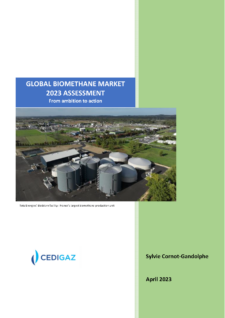
GLOBAL BIOMETHANE MARKET 2024 ASSESSMENT + GLOBAL BIOMETHANE DATABASE
| Non Member | 1990 € | |
| Member | FREE | Login |
CEDIGAZ has just published its 2024 annual report on the global biomethane market which focuses on recent trends in global and regional biomethane markets in 2023. According to CEDIGAZ, global biomethane production expanded to 7.7 billion cubic metres (bcm) in 2022, a growth of 20% compared to 2021, driven by Europe and North America. It is estimated at 9.5 bcm in 2023, an increase of 23%. Driven by strong structural policy and market drivers, the biomethane market is poised for a huge expansion over this decade and beyond. The targets announced by regional and national governments around the world exceed 100 bcm/y by 2030. Reaching this ambitious level requires the adoption of the right policy and regulatory framework, an acceleration of support, and faster permitting, which many governments have put in place in 2023.
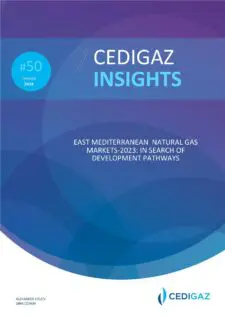
East Mediterranean Natural Gas Markets-2023: in Search of Development Pathways
| Non Member | 2000 € | |
| Member | FREE | Login |
Amidst the gas supply crisis aftermath in Europe and with global spot gas prices remaining in the double-digit range for the past years, the EastMed natural gas sector has been attracting growing attention from major producers, investors, and potential gas buyers. With vast reserves amounting to trillions of cubic meters, the EastMed countries hold the potential to bolster their own energy security and expand global gas export capabilities alleviating pressure in the tight gas market.
The latest CEDIGAZ report “East Mediterranean Natural Gas Markets-2023: in Search of Development Pathways” authored by Alexander Kislov and Gina Cohen, presents a thorough analysis of the development of the EastMed natural gas province, examining the most recent advancements in Egypt, Israel, Türkiye, Cyprus, Jordan, and Lebanon, and perspectives of new large-scale gas exports projects. While the future of the EastMed natural gas province is contingent on various factors, the detailed information and complete data presented in the report provide an opportunity to outline the potential outcomes and contours of the EastMed puzzle.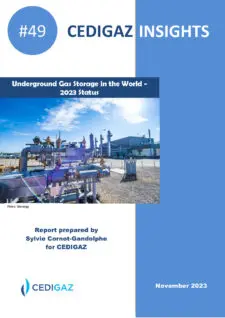
Underground Gas Storage in the World - 2023 Status
| Non Member | 990 € | |
| Member | FREE | Login |
The CEDIGAZ 2023 report highlights significant shifts in the global gas market, with a 1.3% increase in Underground Gas Storage (UGS) capacity, driven by the global gas crisis. Major contributors include China and Europe, with a focus on expanding storage in rapidly developing markets like the Middle East. The report notes a 20% growth in UGS projects in 2022, reflecting the sector's growing importance in natural gas supply security.
The global energy crisis, especially due to Russia's invasion of Ukraine, has reshaped the gas market, leading to more flexible and price-sensitive LNG trade. Governments globally are focusing more on natural gas security, introducing stricter storage regulations and strategic LNG reserves. Japan proposed an international cooperation framework to enhance LNG security.
Europe's RePowerEU plan, a response to Russian aggression, seeks to lessen reliance on Russian fossil fuels, mandating higher gas storage levels. In 2022, storage exceeded EU regulations, reaching 95% by November. Other regions, including Ukraine, the US, China, and the Middle East, are also advancing in UGS, adapting to their specific market needs.
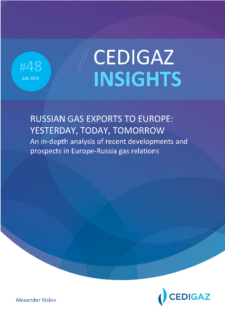
Russian gas in Europe: Yesterday, Today, Tomorrow.
| Non Member | 160 € | |
| Member | FREE | Login |
An in-depth analysis of recent developments and prospects in Europe-Russia gas relations
With quality information from Russia getting increasingly scarce, the Russian natural gas market has become more and more of a black box. In its latest report “Russian gas in Europe: Yesterday, Today, Tomorrow. An in-depth analysis of recent developments and prospects in Europe-Russia gas relations”, CEDIGAZ tracks the unprecedented changes between glorious “yesterday” (2018-2021), gloomy “today” (2022-Q1 2023) of Russian gas (both pipeline and LNG) in Europe, including the evolution of the European countries’ dependence on Russian gas, using data still available. The report also discusses possible futures for Russian gas in Europe after 2023 (“tomorrow”) – given new inputs, including selected pipeline export routes limitations, the Turkish natural gas hub initiative, and Russian LNG project developments.
Russian gas in Europe: Yesterday, Today, Tomorrow - An in-depth analysis of recent developments and prospects in Europe-Russia gas relations. Author: Alexander Kislov – PDF – 55 pages.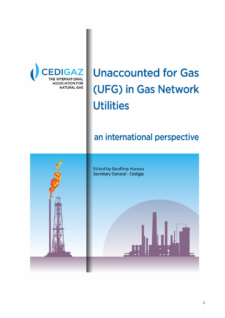
Unaccounted for Gas (UFG) in Gas Network Utilities – An International Perspective
| Member - one license | 999 € | Login |
| Non member - one license | 1999 € |
The unaccounted-for gas (UFG) in gas network utilities, particularly methane emissions, is a pressing environmental and financial concern. With methane being a potent greenhouse gas, efforts to reduce emissions have gained momentum, including the Global Methane Pledge signed by 105 countries. The CEDIGAZ report reveals that UFG contributes approximately 70 billion cubic meters of methane release annually, equivalent to 1.75% of global natural gas demand. This represents a significant impact on global warming and financial losses for utilities. The report explores the sources of UFG and presents solutions, emphasizing the need for accurate measurement, active monitoring, and effective regulations. It underscores the potential for methane emissions reduction in areas like gas flaring and venting and highlights cost-effective strategies to address these issues.
Pricing: €999 for CEDIGAZ members – €1.999 for non-members (Orders made before 31st August 2023 will receive a 20% discount)
GLOBAL BIOMETHANE MARKET 2023 ASSESSMENT + GLOBAL DATABASE - From ambition to action
| Non Member | 1890 € | |
| Member | FREE | Login |
The global biomethane or renewable natural gas industry grew by 23% in 2022 and has potential to surpass 100 billion cubic meters by 2030 with appropriate policies. Energy security concerns, climate change urgency, and methane emission reduction focus have led to new incentivizing policies stimulating investment in the RNG sector. Biomethane is being adopted across sectors worldwide to decarbonize and respond to ESG concerns, and transportation represented half of global demand growth in 2021. The sector has seen unprecedented investment, with European energy majors and financial investors creating dedicated biomethane business units, highlighting biomethane's attributes and exponential growth.
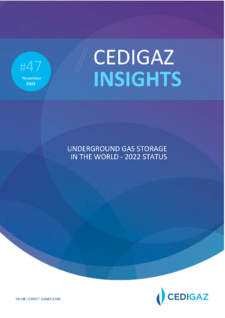
Underground Gas Storage in the World - 2022 Status
| Non Member | 750 € | |
| Member | FREE | Login |
This annual report assesses underground gas storage (UGS) in the world at the end of 2021. It is based and complemented by a comprehensive online database, including detailed statistical information on current and future capacities for the 667 UGS facilities in operation in the world and the 166 UGS projects under construction, planned or potential. Altogether, the database includes 51 countries. The database also includes information on closed, mothballed and inactive UGS facilities, as well as the expansion stages of UGS facilities, when this information is available (see Methodology). The database is available to CEDIGAZ’s members under the infrastructure section of CEDIGAZ website.
This report includes two parts. The first one gives an assessment of UGS capacity at the end of 2021 and new capacity under construction, planned and potential. The second part reviews major trends in UGS in selected key markets: Europe, Ukraine, Russia, the United States, and China. In view of the crucial role of gas storage for security of supply, this review includes an analysis of gas stocks in 2021/22 and winter 2022/23 preparedness. In addition, recent UGS construction activity is reviewed in Central and South America and the Middle East.
This report is based on information available at the beginning of November 2022.
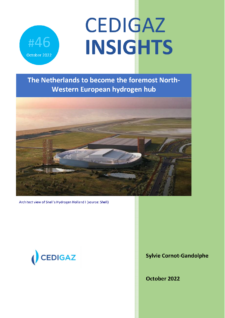
The Netherlands to become the foremost North-Western European hydrogen hub
| Non Member | 750 € | |
| Member | FREE | Login |
This report shows how the Netherlands is advancing its journey towards becoming the foremost hydrogen hub in North-Western Europe (NWE). It contains two types of information: strategic information on the Dutch hydrogen vision and policy, and detailed information on what is going on in the field. Information is updated to July 2022 when Shell took final investment decision (FID) on Holland Hydrogen I with an initial capacity of 200 MW (picture of the cover page). This is an important milestone. Holland Hydrogen I is the first large-scale electrolyzer investment in the Netherlands. It will be Europe's largest renewable hydrogen plant when it starts operation in 2024.
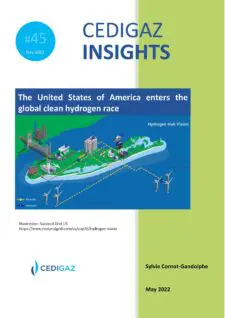
The United States of America enters the global clean hydrogen race
| Non Member | 750 € | |
| Member | FREE | Login |
The International Association Cedigaz has just released its hydrogen report: “The United States of America enters the global clean hydrogen race”, which assesses market developments, policies and prospects of the hydrogen industry in the United States. The report also provides data on US clean hydrogen production projects.
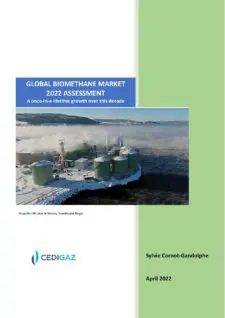
GLOBAL BIOMETHANE MARKET 2022 ASSESSMENT + DATABASE
| Non Member | 1850 € | |
| Member | FREE | Login |
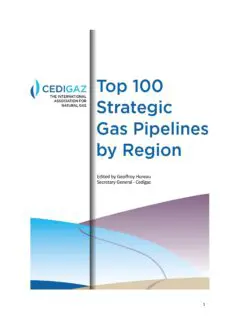
Top 100 Strategic Gas Pipelines
| Member - one license | 9950 € | Login |
| Non member - one license | 9950 € |
- Pipeline ownership – Project structure, shareholders, and their respective shares,
- Technical characteristics – Including pipeline length, diameter, wall thickness and grade of steel used and the pipeline route.
- Pipeline route – Including a bespoke map for each pipeline detailing the route and lengths
- Pipeline construction data – Including CAPEX data relating to the original cost of the pipeline, as well as the cost of subsequent upgrades together with details of the main EPC construction contractors used.
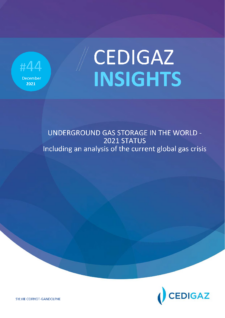
Underground Gas Storage in the World 2021 Status
| Non Member | 500 € | |
| Member | FREE | Login |
This annual report assesses underground gas storage (UGS) in the world at the end of 2020. It is based and complemented by a comprehensive online database, including detailed statistical information on current and future capacities for the 661 UGS facilities in operation in the world and the 91 new projects under construction, planned or potential. Altogether, the database includes 51 countries. The database also includes information on closed, mothballed and inactive UGS facilities, as well as the expansion stages of UGS facilities, when this information is available (see Methodology). The database is available to CEDIGAZ’s members under the infrastructure section of CEDIGAZ website.
This report includes three parts. Due to the exceptional events on the gas (and energy) scene in 2021, this year’s report includes an analysis of the main causes of the elevated European and North Asian spot gas prices (Part 1). Then, the report gives an assessment of UGS key metrics in 2020 and their evolution compared to 2019. The third part reviews major trends in UGS in selected key markets: Europe, Ukraine, Russia, USA, and China. In addition, recent UGS construction activity is reviewed in South and Central America and the Middle East.
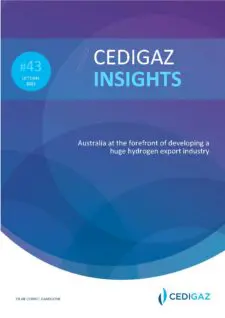
AUSTRALIA AT THE FOREFRONT OF DEVELOPING A HUGE HYDROGEN EXPORT INDUSTRY
| Non Member | 750 € | |
| Member | FREE | Login |
The Australian government released the National Hydrogen Strategy (the Strategy) in November 2019 and has continued to outline its support for hydrogen through the First Low-Emissions Technology Statement, released in September 2020. The government has stated its commitment to reducing Australia’s emissions through technology investment, rather than through carbon pricing, with the Technology Investment Roadmap a core element of its long-term emissions reduction strategy.
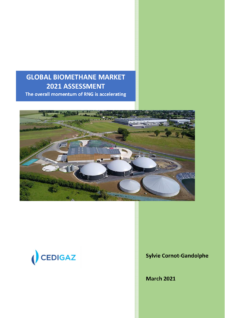
GLOBAL BIOMETHANE MARKET 2021 ASSESSMENT (Report and Database)
| Non Member | 1770 € | |
| Member | FREE | Login |
This report updates the 2019 CEDIGAZ’s comprehensive study on global biomethane (also known as renewable natural gas, RNG). It focuses on biogas upgrading and looks at key developments in the marketplace, policies, and major markets. Global RNG production reached 4 bcm in 2019, a doubling since 2015. There are now close to 1,000 biogas upgrading plants operating in the world. The market remains dominated by Europe (2.4 bcm), but the United States is catching up rapidly and, in fact, has become the world’s leading producer (1.1 bcm), ahead of Germany. In other regions, biomethane production is still limited (0.4 bcm collectively), but the market is taking off in Brazil, Canada, China and India. Recent years have seen significant shifts in terms of key sources of demand and market drivers. Hard-to-abate sectors (road transportation, shipping, heat) are becoming the focus of support policies, while cost reduction in wind and solar power generation makes the use of biomethane in the power sector less attractive, except for providing flexibility. RNG is more and more recognized for its key role in decarbonizing and bringing sustainability in the agriculture and waste sectors and is increasingly included in climate policies targeting these sectors.

GLOBAL BIOMETHANE MARKET 2021 ASSESSMENT (Report)
| Non Member | 990 € | |
| Member | FREE | Login |
This report updates the 2019 CEDIGAZ’s comprehensive study on global biomethane (also known as renewable natural gas, RNG). It focuses on biogas upgrading and looks at key developments in the marketplace, policies, and major markets. Global RNG production reached 4 bcm in 2019, a doubling since 2015. There are now close to 1,000 biogas upgrading plants operating in the world. The market remains dominated by Europe (2.4 bcm), but the United States is catching up rapidly and, in fact, has become the world’s leading producer (1.1 bcm), ahead of Germany. In other regions, biomethane production is still limited (0.4 bcm collectively), but the market is taking off in Brazil, Canada, China and India. Recent years have seen significant shifts in terms of key sources of demand and market drivers. Hard-to-abate sectors (road transportation, shipping, heat) are becoming the focus of support policies, while cost reduction in wind and solar power generation makes the use of biomethane in the power sector less attractive, except for providing flexibility. RNG is more and more recognized for its key role in decarbonizing and bringing sustainability in the agriculture and waste sectors and is increasingly included in climate policies targeting these sectors.
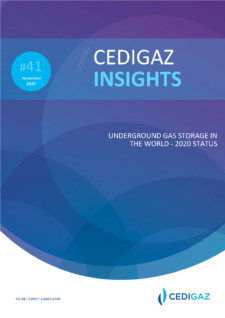
UNDERGROUND GAS STORAGE IN THE WORLD - 2020 STATUS
| Non Member | 150 € | |
| Member | FREE | Login |
The dramatic developments in gas markets in 2019-2020, with an acute oversupply situation due to the negative impact of the COVID-19 pandemic on demand and compounded by the massive increase of LNG supply from the US has stressed the fundamental importance of European Underground Gas Storage, assisted by Ukrainian UGS, to alleviate the imbalance of global gas markets. While until recently, UGS has mainly been developed in North America, Europe and the C.I.S., China is now on the fast lane for storage development. Russia, although the second global UGS capacity holder is still developing its storage infrastructure to serve both domestic and export markets.
This new report by CEDIGAZ provides an insightful review of storage activity in 4 key markets in 2020 and highlights the crucial role of UGS in balancing the global gas market as well as increasing security of gas supply in the context of rising geopolitical risks and trade tensions. The report also includes data on operating, under construction and planned facilities detailed by country.
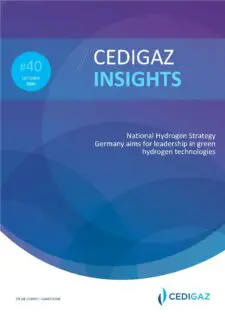
Germany aims for leadership in green hydrogen technologies
| Non Member | 750 € | |
| Member | FREE | Login |
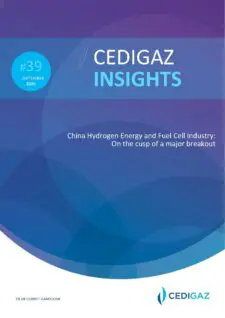
China Hydrogen Energy and Fuel Cell Industry: On the cusp of a major breakout
| Non Member | 750 € | |
| Member | FREE | Login |
Looking ahead, the Chinese hydrogen energy sector is on the cusp of a major breakout. In the context of the 14th Five-Year Plan (2021-2025), the central government is planning a new development path of the sector. The development of hydrogen energy is of great significance for China to achieve its energy transition, promote new industrial chains, and ensure the country’s energy independence. Draft policy documents consider the recognition of hydrogen as an energy source, the establishment of a national strategic plan and roadmap for the sector, and the set-up of rules, codes and standards for hydrogen energy.
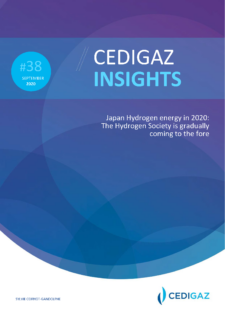
JAPAN HYDROGEN ENERGY IN 2020: THE HYDROGEN SOCIETY IS GRADUALLY COMING TO THE FORE
| Member | FREE | Login |
| Non Member | 750 € |
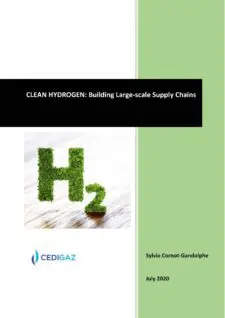
CLEAN HYDROGEN: BUILDING LARGE-SCALE SUPPLY CHAINS
| Non Member | 1680 € | |
| Member | FREE | Login |
Since 2017, governments from 18 countries have adopted national hydrogen strategies for deploying clean (low and zero carbon) hydrogen energy solutions. Leading companies around the world are proactively investing in clean hydrogen and related technologies. The transition to clean hydrogen would create a significant step-change in hydrogen production technology in terms of scale and costs, making clean hydrogen solutions more attractive not only for industry, but also in all other sectors. Clean hydrogen is an emerging market. It is a key lever for achieving deep decarbonisation, specifically in hard-to-abate sectors like transport. It can tackle various critical energy challenges, including facilitating the large-scale integration of intermittent renewables, enabling grid balancing and seasonal storage. It can also help to improve air quality and strengthen energy security. Its potential is immense and future developments depend on energy and environmental policies, cost reductions and competition with other low-carbon options.
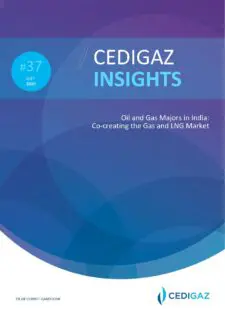
Oil and Gas Majors in India: Co-creating the Gas and LNG Market
The entry of big players into the downstream gas market, in partnerships with strong Indian partners, offers a key leverage to the Indian vision to realise a gas market-based economy. They can deliver competitive and affordable LNG supplies and accelerate gas infrastructure build out, thus solving two key bottlenecks on the Indian gas market. Energy majors will facilitate and accelerate gas market growth and enlarge the gas market with innovative solutions adapted to Indian conditions. A larger gas sector augurs well with Indian economy as well as for the environment and is a win-win situation for all stakeholders.
While the COVID-19 crisis has introduced an additional uncertainty to natural gas demand growth, the Indian gas market fundamentals are robust and long-term growth propects remain strong.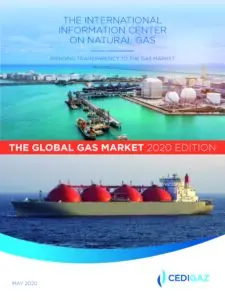
THE GLOBAL GAS MARKET 2020 EDITION
The demand for natural gas continued to display sustained growth in 2019 (+2.3%), to the detriment of coal. This growth is lower compared to the two previous years but in line with the historic 10-year average.
The main factor was the competitiveness of gas in a context of oversupply which encouraged switching from coal in the power and industry sectors, chiefl y in the United States and the EU.
As a result, the share of gas in the energy mix continued to rise. Today, this share is estimated to be 23%, compared to 21% in 2010. Recent developments suggest that the power market has embraced the energy transition through a growing role of natural gas and renewables.
The US remained the largest contributor to both supply and demand growth thanks to the abundance of low-cost shale and associated gas resources. US gas production continued to increase in 2019 at a much faster rate than consumption, thereby creating a large surplus destined for exports.
China was the second largest demand growth area again, even if the expansion of gas demand slowed to 8.6% in a context of weaker economic growth and the relaxation of Chinese policy on coal-to-gas switching.
International trade (net fl ows) expanded strongly by almost 4% only due to the growing abundance of highly competitive LNG supply which displaced pipeline gas, especially in Europe. LNG demand growth slowed in Asia, while Europe absorbed much of the surplus LNG, acting as a balancing market.
As global natural gas supply growth largely outpaced demand growth, a significant amount of natural gas was injected into storages. In a context of LNG overhang, spot prices on the Asian and European markets plunged by more than 40% compared to 2018. New pricing and trading patterns reshape the global gas market which increasingly relies on spot-priced and fl exible gas supply.
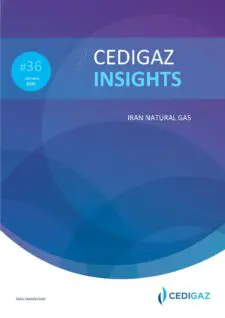
IRAN NATURAL GAS
| Non Member | 1200 € | |
| Member | FREE | Login |
Iran has one of the largest proven natural gas reserves in the world, hosts about 17% of the world’s proven natural gas reserves. Iran is also the world’s third–largest dry natural gas producer after the United States and Russia.
This report Dr Sara Vakhshouri founder and president of SVB Energy International and renown specialist of the Iranian energy sector provide an update of Iranian Gas Chain under US sanctions
Contents:- Historical background
- Gas reserves & Exploration
- Development & Production
- Gas Refining & Production at Refineries
- Natural Gas Consumption, Import & Export
- Underground Gas Storage
- Gas Condensate Production
- Implication of US sanctions
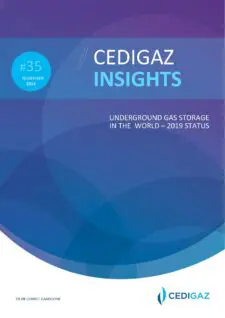
Underground Gas Storage in the World - 2019 Status
- At the end 2018, there were 662 underground gas storage (UGS) facilities in operation in the world. The global working gas capacity reached 421 bcm
- North America concentrates more than two thirds of the sites and accounts for almost 40% of global working gas capacity and half of global deliverability, the top five countries (United States, Russia, Ukraine, Canada and Germany) account for 70% of the worldwide capacities
- Storage in depleted fields dominate with 79% of global working gas volumes, but storage in salt caverns now accounts for 26% of global deliverability
- In 2018, the growth in gas storage capacity contrasted with the trends observed since 2015
- At worldwide level, there are 102 identified projects at different stages of planning
- UGS development activity is dominated by China, which alone accounts for almost half of the 37 bcm of working gas capacity under construction

A NEW ERA FOR CCUS DRIVEN BY CONTRASTED POLICIES AND BUSINESS MODELS: US AND EUROPEAN APPROACHES
| Non Member | 990 € | |
| Member | FREE | Login |
Following a period of low activity and weakening interest in recent years, CCUS is back into the limelight, especially in the US and in Europe, in the wake of the Paris agreement, boosted by a growing interest in hydrogen, rising carbon prices, new supporting policies and new business models.
This report provides an update on CCUS globally with a focus on Europe and the US, the two leading areas for this technology.
Contents:- Introduction: CCUS is back on policy makers’ agenda
- Growing policy attention and support for CCUS
- Global status of CCUS
- Barriers, challenges and required policies
- United States: Growing carbon capture & CO2-EOR industry
- Renewed interest and policy support in Europe
- Conclusion
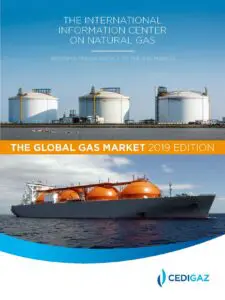
THE GLOBAL GAS MARKET 2019 EDITION
2018 has been a remarkable year for the global natural gas market. Global natural gas demand surged 4.7% to 3,850 bcm, driven by the US and China. The US was the standout performer, accounting for 45% of the global increase in both the consumption and supply of natural gas.
2018 marks the second year of strong growth of natural gas demand, after a 3.5 % rise in 2017. It also recorded the highest growth of gas demand since the post-crisis rebound of 2010.
This fast expansion was driven by the abundance of competitive gas supply, especially in the US and in Russia and by supportive energy and environmental policies, in some countries, particularly in China. Investment in transport infrastructure also contributed to bolster gas penetration in key markets.
China became the largest net importer of natural gas in the world before Japan. Chinese net imports jumped by 32% and accounted for more than 80% of the global increase in net imports, once again highlighting the crucial role of China in absorbing global gas production.
Like in 2017, the expansion of natural gas demand was part of a substantial global growth in world energy demand, driven by a robust global economy and extreme weather conditions.
Strong gas demand growth in Asia contributed to a rise in market prices in key areas and prevented the formation of a global LNG bubble.
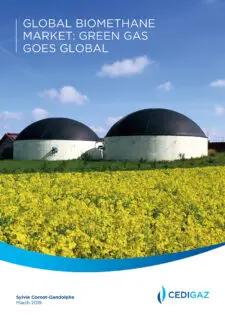
Global biomethane market: Green Gas Goes Global
| Member - unlimited online access | 500 € | Login |
| Non member - 5 licenses | 2500 € |
This report provides a detailed analysis of the booming biomethane market as governments around the world increasingly recognize the many benefits of renewable natural gas.
Since 2010, world biomethane production has increased exponentially, reaching three billion cubic meters in 2017 and there will soon be more than 1,000 biomethane production plants operating in thirty-four countries, up from 720 at year-end 2017.
For many years a European phenomenon, Green Gas is Going Global.
The report contains three parts:
- An overview of global biomethane production and markets, biogas upgrading plants, key drivers and future trends (region by region)
- Country reviews for forty countries in Europe, North America, Asia, Central & South America and Africa
- In-depth case studies on key developed and emerging biomethane markets, e.g. U.S., Canada, Brazil, Germany, France, China and India.
It complements the CEDIGAZ Global Biomethane Database
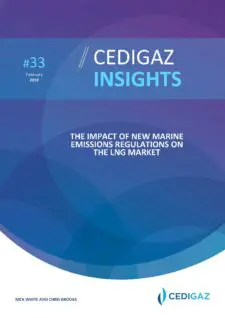
THE IMPACT OF NEW MARINE EMISSIONS REGULATIONS ON THE LNG MARKET
-
- What are the IMO emissions standards coming into force in 2020 and where do they apply?
- What are the possible options for ship owners?
- What are the opportunities for the LNG market?
- Current state of play – how is the industry planning for the 2020 regulations?
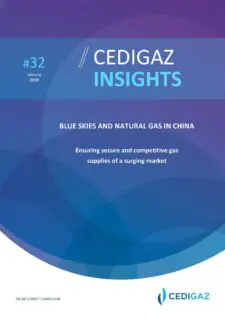
BLUE SKIES AND NATURAL GAS IN CHINA
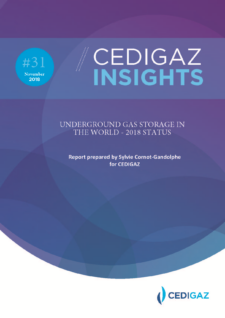
Underground Gas Storage in the World - 2018 Status
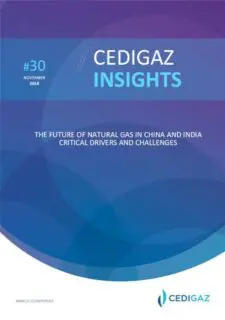
The Future of Natural Gas in China and India - Critical Drivers and Challenges
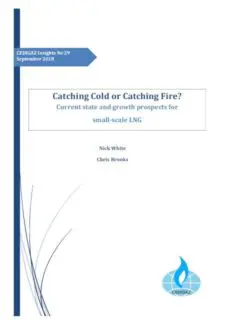
Catching Cold or Catching Fire? Current state and growth prospects for small-scale LNG
| Member | FREE | Login |
| Non Member | 1000 € |
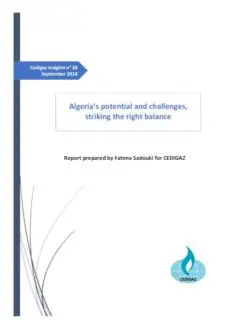
Algeria's potential and challenges, striking the right balance
| Member | FREE | Login |
| Non Member | 1000 € |
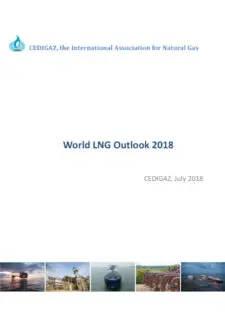
Medium and Long Term LNG Outlook 2018
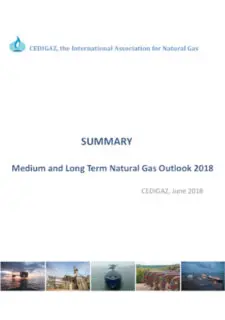
Medium and Long Term Natural Gas Outlook 2018
| Member | FREE | Login |
| Non Member | 500 € |
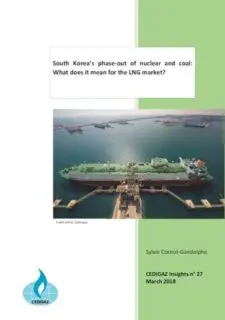
South Korea's phase-out of nuclear and coal: what does it mean for the LNG market?
| Member | FREE | Login |
| Non Member | 1000 € |
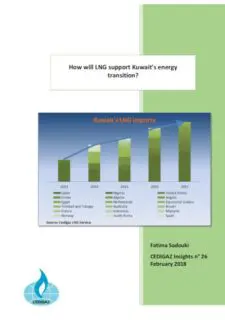
How will LNG support Kuwait's energy transition?
| Member | FREE | Login |
| Non Member | 1000 € |
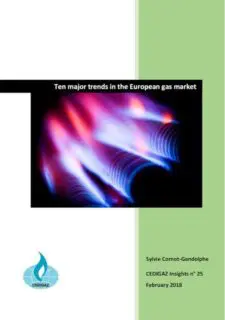
Ten major trends in the European gas market
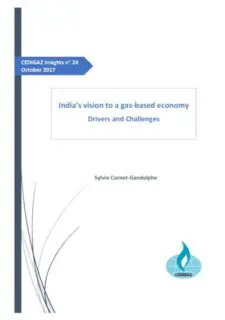
India's vision to a gas-based economy, drivers and challenges
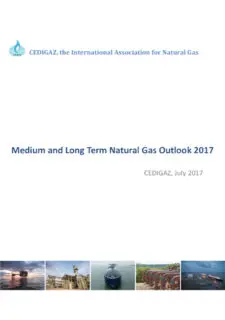
Medium and Long Term Natural Gas Outlook 2017
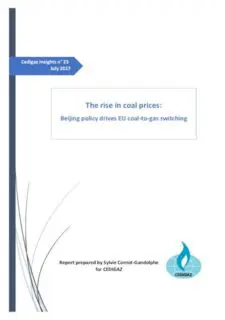
The rise in coal prices: Beijing policy drives EU coal-to-gas switching
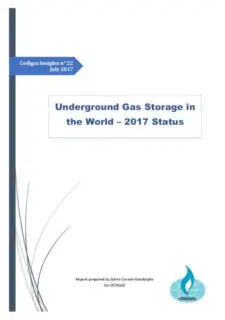
Overview of Underground Gas Storage in the World 2017–Status
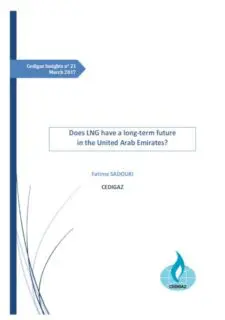
Does LNG have a long-term future in the United Arab Emirates?
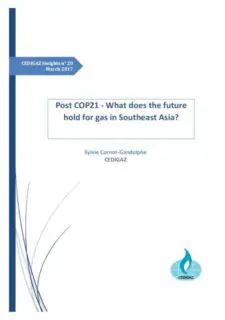
Post COP21 - What does the future hold for gas in Southeast Asia?
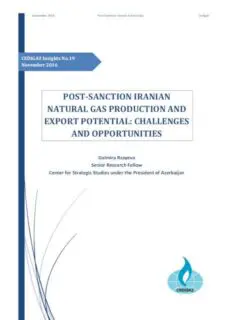
Post-Sanction Iranian Natural Gas Production and Export Potential: Challenges and Opportunities
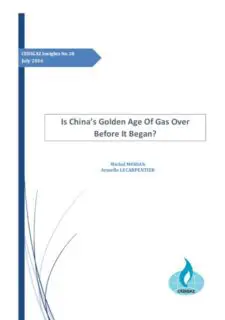
Is China's Golden Agen Of Gas Over Before It Began?
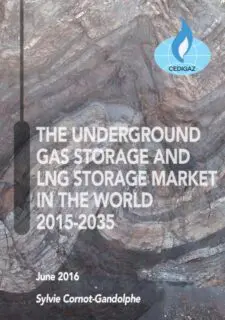
Underground Gas Storage & LNG Storage Market in the Word 2015-2035
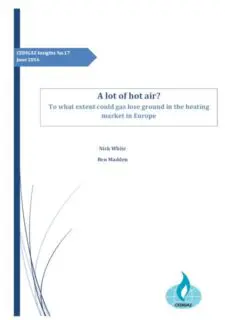
A lot of hot air? To what extent could gas lose ground in the heating market in Europe
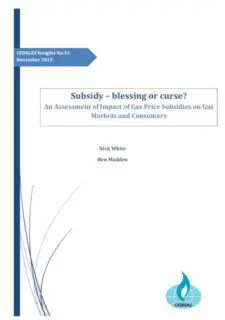
Subsidy – blessing or curse? An Assessment of Impact of Gas Price Subsidies on Gas Markets and Consumers
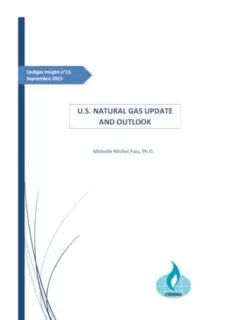
U.S. Natural Gas Update and Outlook
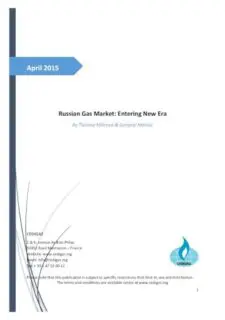
Russian Gas Market: Entering New Era
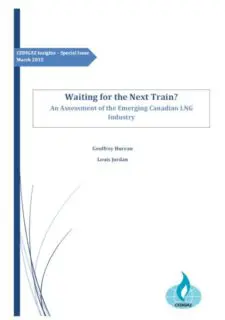
Waiting for the Next Train? An Assessment of the Emerging Canadian LNG Industry
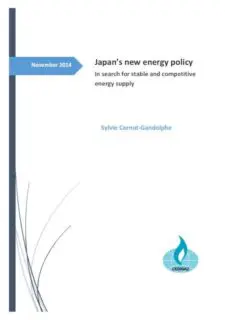
Japan's New Energy Policy - In search for stable and competitive energy supply
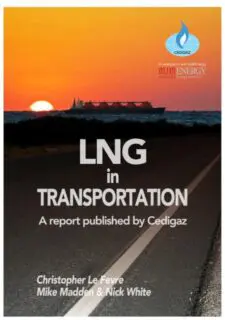
LNG IN TRANSPORTATION
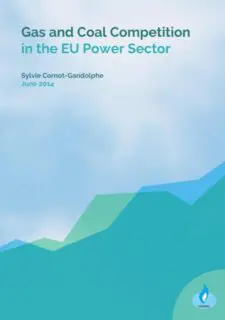
Gas and Coal Competition in the EU Power Sector
CEDIGAZ publications
- Biogas - Biomethane - Green Gas
- CCS - Carbon Capture and Storage
- CEDIGAZ Insights
- Country Report
- Energy Transition
- First Estimates
- Free downloads
- Gas-Coal Competition
- Hydrogen
- LNG Markets
- Natural Gas Markets
- Natural Gas Statistics
- Outlooks
- Small Scale LNG
- Thematic reports
- UGS - Underground Gas Storage
- Zero Carbon Gas



